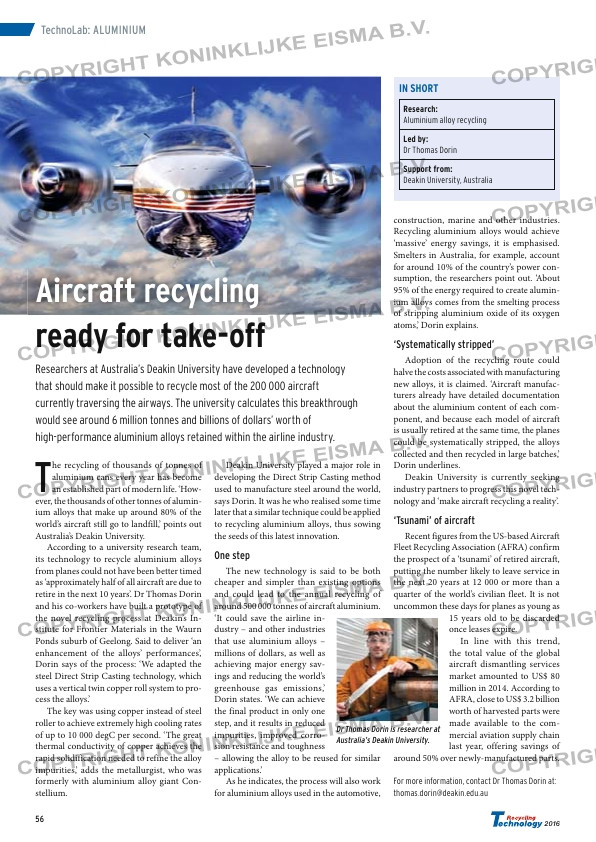Page 54 from: Recycling Technology 2016

56
2016
TechnoLab: ALUMINIUM
ready for take-off
Researchers at Australia’s Deakin University have developed a technology
that should make it possible to recycle most of the 200 000 aircraft
currently traversing the airways. The university calculates this breakthrough
would see around 6 million tonnes and billions of dollars’ worth of
high-performance aluminium alloys retained within the airline industry.
T
he recycling of thousands of tonnes of
aluminium cans every year has become
an established part of modern life. ‘How-
ever, the thousands of other tonnes of alumin-
ium alloys that make up around 80% of the
world’s aircraft still go to landfill,’ points out
Australia’s Deakin University.
According to a university research team,
its technology to recycle aluminium alloys
from planes could not have been better timed
as ‘approximately half of all aircraft are due to
retire in the next 10 years’. Dr Thomas Dorin
and his co-workers have built a prototype of
the novel recycling process at Deakin’s In-
stitute for Frontier Materials in the Waurn
Ponds suburb of Geelong. Said to deliver ‘an
enhancement of the alloys’ performances’,
Dorin says of the process: ‘We adapted the
steel Direct Strip Casting technology, which
uses a vertical twin copper roll system to pro-
cess the alloys.’
The key was using copper instead of steel
roller to achieve extremely high cooling rates
of up to 10 000 degC per second. ‘The great
thermal conductivity of copper achieves the
rapid solidification needed to refine the alloy
impurities,’ adds the metallurgist, who was
formerly with aluminium alloy giant Con-
stellium.
Deakin University played a major role in
developing the Direct Strip Casting method
used to manufacture steel around the world,
says Dorin. It was he who realised some time
later that a similar technique could be applied
to recycling aluminium alloys, thus sowing
the seeds of this latest innovation.
One step
The new technology is said to be both
cheaper and simpler than existing options
and could lead to the annual recycling of
around 500 000 tonnes of aircraft aluminium.
‘It could save the airline in-
dustry – and other industries
that use aluminium alloys –
millions of dollars, as well as
achieving major energy sav-
ings and reducing the world’s
greenhouse gas emissions,’
Dorin states. ‘We can achieve
the final product in only one
step, and it results in reduced
impurities, improved corro-
sion resistance and toughness
– allowing the alloy to be reused for similar
applications.’
As he indicates, the process will also work
for aluminium alloys used in the automotive,
construction, marine and other industries.
Recycling aluminium alloys would achieve
‘massive’ energy savings, it is emphasised.
Smelters in Australia, for example, account
for around 10% of the country’s power con-
sumption, the researchers point out. ‘About
95% of the energy required to create alumin-
ium alloys comes from the smelting process
of stripping aluminium oxide of its oxygen
atoms,’ Dorin explains.
‘Systematically stripped’
Adoption of the recycling route could
halve the costs associated with manufacturing
new alloys, it is claimed. ‘Aircraft manufac-
turers already have detailed documentation
about the aluminium content of each com-
ponent, and because each model of aircraft
is usually retired at the same time, the planes
could be systematically stripped, the alloys
collected and then recycled in large batches,’
Dorin underlines.
Deakin University is currently seeking
industry partners to progress this novel tech-
nology and ‘make aircraft recycling a reality’.
‘Tsunami’ of aircraft
Recent figures from the US-based Aircraft
Fleet Recycling Association (AFRA) confirm
the prospect of a ‘tsunami’ of retired aircraft,
putting the number likely to leave service in
the next 20 years at 12 000 or more than a
quarter of the world’s civilian fleet. It is not
uncommon these days for planes as young as
15 years old to be discarded
once leases expire.
In line with this trend,
the total value of the global
aircraft dismantling services
market amounted to US$ 80
million in 2014. According to
AFRA, close to US$ 3.2 billion
worth of harvested parts were
made available to the com-
mercial aviation supply chain
last year, offering savings of
around 50% over newly-manufactured parts.
For more information, contact Dr Thomas Dorin at:
[email protected]
IN SHORT
Research:
Aluminium alloy recycling
Led by:
Dr Thomas Dorin
Support from:
Deakin University, Australia
Aircraft recycling
Dr Thomas Dorin is researcher at
Australia’s Deakin University.



